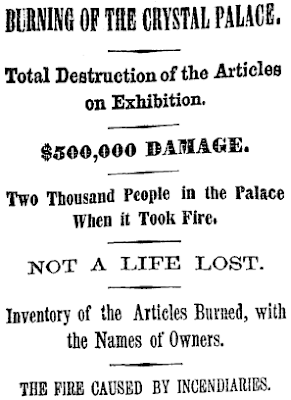Samuel Ward Francis' 1857 patent model typewriter is in the Smithsonian's National Museum of American History in Washington DC today because some brave soul saved it from the New York Crystal Palace fire 157 years ago.
On October 7, 1858, two days after the fire, The New York Times reported:
A day earlier, the Times had feared the worst, listing Francis' typewriter among the many machines destroyed in the fire:
Francis may not have been immediately aware that his machine had been saved - unless, of course, by "the young man in charge", the Times meant Francis himself, as he was just 22 at the time.
Also, the Times did not make it clear whether it was this young man who saved the typewriter, or the typewriter itself, which had suffered "but slight injury". Here it is on its original table, with the top section in place:
We might assume it was the attendant, because the complete machine looked in pretty good nick, for its age, in the Smithsonian when this photograph was taken (on another table) in the mid-1990s:
And here is Hope Simmons using it at the Smithsonian in July 1928:
Assuming the "young man" was not Francis himself, does this Museum of the City of New York blog comment offer a hint to his identify? "I am trying to solve a mystery connected to the Crystal Palace fire of 1858. In my possession is a gentleman’s walking stick inscribed and given to a
Frances C. Tredwell, who allegedly rushed into the fire and saved some artifacts before the building collapsed. It was signed by a Hector Brollin."
I ask because, apart from his typewriter table, Francis lost a case of his omnibus fare-paying canes, which were also on exhibit. Such a thing could well be mistaken for a walking stick. The Times reported on October 6 that a "Mr Treadwell" had a refreshment franchise at the fair (he lost everything):
The New York Crystal Palace was an exhibition building
constructed for the Exhibition of the Industry of All Nations in New York City
in 1853. The
building stood in Reservoir Square.
The
New York Crystal Palace was directly inspired by the Crystal Palace built in
London's Hyde Park to house the Great Exhibition of 1851. Like the Crystal Palace of London, it was constructed from iron and
glass.
The New York Crystal Palace was destroyed by fire on October 5,
1858, while the 30th annual fair of the American Institute was being held there.
The fire began in a lumber room on the side adjacent to 42nd Street. Within 15 minutes the building's dome fell and in 25 minutes the entire structure
had burned to the ground. No lives were lost but the loss of property amounted
to more than $350,000. This included the building, valued at $125,000, and
exhibits and valuable statuary remaining from the 1853 World's Fair.
Francis had received the patent for his typewriter almost exactly a year earlier, when he was aged 21. He had, at the time, just graduated from Columbia College and
entered the University of New York, where from 1859-60 he was a member of Professor Valentine Mott's surgical
staff. Samuel’s father, John Wakefield Francis, had started
his working life as an apprentice printer before becoming a physician.













3 comments:
I've never seen a typewriter like that. I did know of the Crystal Palace Fire though. Firehouse magazine had a detailed article, back in the 70's I think, on the fire. My move to Florida necessitated leaving my collection of decades of various magazines, and some other fire service memorabilia behind.
Hooray for the "young man"!
Thanks for sharing this nice article it have some great useful blog....
Post a Comment